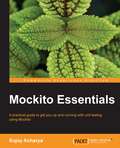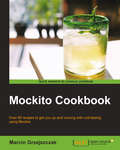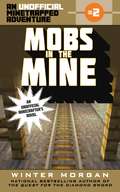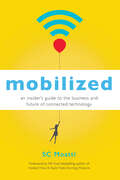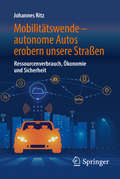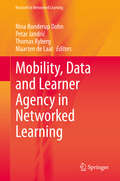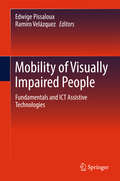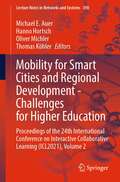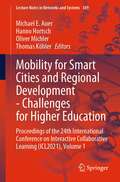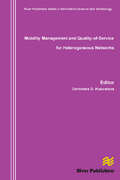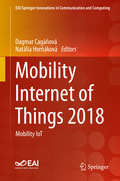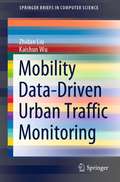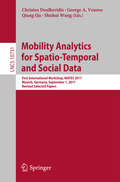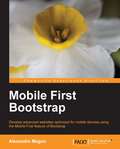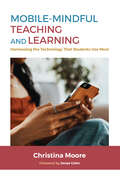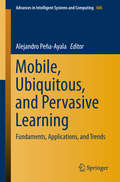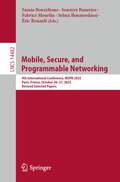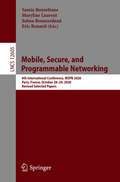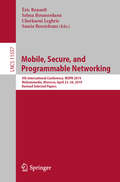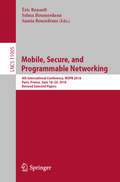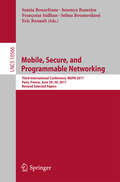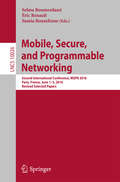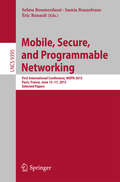- Table View
- List View
Mockito Essentials
by Sujoy AcharyaThis book is ideal for developers who have some experience in Java application development as well as some basic knowledge of test doubles and JUnit testing. This book also introduces you to the fundamentals of JUnit testing, test doubles, refactoring legacy code, and writing JUnit tests for GWT and web services.
Mockito Cookbook
by Marcin GrzejszczakThis is a focused guide with lots of practical recipes with presentations of business issues and presentation of the whole test of the system. This book shows the use of Mockito's popular unit testing frameworks such as JUnit, PowerMock, TestNG, and so on. If you are a software developer with no testing experience (especially with Mockito) and you want to start using Mockito in the most efficient way then this book is for you. This book assumes that you have a good knowledge level and understanding of Java-based unit testing frameworks.
Mobs in the Mine (The Unofficial Minetrapped Adventure #2)
by Winter MorganLily, Simon, and Michael are still trapped in their Minecraft game, but with new friends and a better understanding of their arch enemy Mr. Anarchy, they’re getting closer to finding a way home. But before they can fight the evil griefer and escape the game, the friends need to replenish their resources-and that means trekking deeper into the Overworld.When their mining party is attacked and hostile mobs reveal surprising new powers, it looks like the end for the trio-and for all their friends in town. Will Lily, Simon, and Michael find a way to defeat the mobs and save their village? Will they ever conquer Mr. Anarchy and escape from the Overworld?Find out in this exciting, action-packed second book in the Unofficial Minetrapped Adventures series by bestselling author Winter Morgan.Sky Pony Press, with our Good Books, Racehorse and Arcade imprints, is proud to publish a broad range of books for young readers-picture books for small children, chapter books, books for middle grade readers, and novels for young adults. Our list includes bestsellers for children who love to play Minecraft; stories told with LEGO bricks; books that teach lessons about tolerance, patience, and the environment, and much more. While not every title we publish becomes a New York Times bestseller or a national bestseller, we are committed to books on subjects that are sometimes overlooked and to authors whose work might not otherwise find a home.
Mobilized: An Insider’s Guide to the Business and Future of Connected Technology
by SC MoattiMobile has now become such an integral part of how we live that, for many people, losing a cell phone is like losing a limb. Everybody knows mobile is the future, and every business wants in, but what are the elements of mobile success? SC Moatti, a Silicon Valley veteran who was an executive with Facebook, Trulia, and Nokia, gives businesses and professionals simple ways to thrive in this modern day "gold rush." More than a book on technology, this is a book about human nature and what matters most to us. Moatti shows that because mobile products have become extensions of ourselves, we expect from them what we wish for ourselves: an attractive body, a meaningful life, and a growing repertoire of skills. She has created an all-encompassing formula that makes it easy for any business to develop a strategy for creating winning mobile products.Her Body Rule dictates that mobile products must appeal to our sense of beauty—but beauty in a mobile world is both similar to and different from what it means offline. The Spirit Rule says mobile products must help us address our deepest personal needs. And the Mind Rule explains that businesses that want to succeed in mobile need to continually analyze the user experience so they can improve every iteration of their products. Moatti includes case studies from mobile pioneers such as Facebook, Uber, Tinder, WhatsApp, and more. The market is full of how-to books for programming apps, but no works examine what is required for success in the mobile era. Until now.
Mobilitätswende – autonome Autos erobern unsere Straßen
by Johannes RitzDieses Buch beleuchtet die unterschiedlichen Facetten einer Mobilität mit selbstfahrenden (autonomen) Fahrzeugen. Angefangen bei der Elektromobilität, werden die Parkplatzproblematik, Carsharing und Haftungsfragen unter dem Aspekt einer zunehmenden Verbreitung autonomer Fahrzeuge betrachtet. Auch ökonomische und umweltpolitische Fragen sind aufgeworfen (Ressourcenknappheit, Klimawandel, automatisierte Logistik) und versucht zu beantworten. Können Maschinen moralisch handeln, wie steht es um die Cybersicherheit und den Technikmissbrauch, sind weitere Fragen, die in diesem Buch thematisiert werden.
Mobility, Data and Learner Agency in Networked Learning (Research in Networked Learning)
by Thomas Ryberg Maarten De Laat Petar Jandrić Nina Bonderup DohnThe chapters in this book are based on selected peer reviewed research papers presented at the 11th biennial Networked Learning Conference (NLC) 2018 held in Zagreb and were chosen as exemplars of cutting edge research on networked learning. The chapters are organized into three main sections: 1) Aspects of mobility for Networked Learning in a global world, 2) Use and misuse of algorithms and learning analytics, 3) Understanding and empowering learners. The three main sections are flanked by chapters which introduce and reflect on Networked Learning as epistemic practice. The concluding chapter draws out perspectives from the chapters and discusses emerging issues. The book focuses on the nature of learning and interactions as an important characteristic sought out by researchers and practitioners in this field.
Mobility of Visually Impaired People
by Edwige Pissaloux Ramiro VelazquezThis book discusses the design of the new mobility assistive information and communication technologies (ICT) devices for the visually impaired. The book begins with a definition of the space concept, followed by the concept of interaction with a space during mobility and this interaction characteristics. The contributors will then examine the neuro-cognitive basis of space perception for mobility and different theories of space perception. The text presents the existing technologies for space perception (sense recovery with stem and iPS cells, implants, brain plasticity, sensory substitution devices, multi modal technologies, etc.), the newest technologies for mobility assistance design, the way the feedback on environment is conveyed to the end-user. Methods for formative and summative evaluations of the mobility devices will also be discussed. The book concludes with a look to the future trends in research and technology development for mobility assistive information and communication technologies. <P><P><i>Advisory: Bookshare has learned that this book offers only partial accessibility. We have kept it in the collection because it is useful for some of our members. Benetech is actively working on projects to improve accessibility issues such as these.</i>
Mobility for Smart Cities and Regional Development - Challenges for Higher Education: Proceedings of the 24th International Conference on Interactive Collaborative Learning (ICL2021), Volume 2 (Lecture Notes in Networks and Systems #390)
by Michael E. Auer Thomas Köhler Hanno Hortsch Oliver MichlerThis book presents recent research on interactive collaborative learning. We are currently witnessing a significant transformation in the development of education and especially post-secondary education. To face these challenges, higher education has to find innovative ways to quickly respond to these new needs. On the one hand, there is a pressure by the new situation in regard to the COVID pandemic. On the other hand, the methods and organizational forms of teaching and learning at higher educational institutions have changed rapidly in recent months. Scientifically based statements as well as excellent experiences (best practice) are absolutely necessary.These were the aims connected with the 24th International Conference on Interactive Collaborative Learning (ICL2021), which was held online by Technische Universität Dresden, Germany, on 22–24 September 2021.Since its beginning in 1998, this conference is devoted to new approaches in learning with a focus on collaborative learning in Higher Education. Nowadays, the ICL conferences are a forum of the exchange of relevant trends and research results as well as the presentation of practical experiences in Learning and Engineering Pedagogy. In this way, we try to bridge the gap between ‘pure’ scientific research and the everyday work of educators.This book contains papers in the fields ofTeaching Best PracticesResearch in Engineering PedagogyEngineering Pedagogy EducationEntrepreneurship in Engineering EducationProject-Based LearningVirtual and Augmented LearningImmersive Learning in Healthcare and Medical Education.Interested readership includes policymakers, academics, educators, researchers in pedagogy and learning theory, schoolteachers, learning industry, further and continuing education lecturers, etc
Mobility for Smart Cities and Regional Development - Challenges for Higher Education: Proceedings of the 24th International Conference on Interactive Collaborative Learning (ICL2021), Volume 1 (Lecture Notes in Networks and Systems #389)
by Michael E. Auer Thomas Köhler Hanno Hortsch Oliver MichlerThis book presents recent research on interactive collaborative learning. We are currently witnessing a significant transformation in the development of education and especially post-secondary education. To face these challenges, higher education has to find innovative ways to quickly respond to these new needs. On the one hand, there is a pressure by the new situation in regard to the COVID pandemic. On the other hand, the methods and organizational forms of teaching and learning at higher educational institutions have changed rapidly in recent months. Scientifically based statements as well as excellent experiences (best practice) are absolutely necessary.These were the aims connected with the 24th International Conference on Interactive Collaborative Learning (ICL2021), which was held online by Technische Universität Dresden, Germany, on 22–24 September 2021.Since its beginning in 1998, this conference is devoted to new approaches in learning with a focus on collaborative learning in Higher Education. Nowadays, the ICL conferences are a forum of the exchange of relevant trends and research results as well as the presentation of practical experiences in Learning and Engineering Pedagogy. In this way, we try to bridge the gap between ‘pure’ scientific research and the everyday work of educators.This book contains papers in the fields of Teaching Best Practices Research in Engineering Pedagogy Engineering Pedagogy Education Entrepreneurship in Engineering Education Project-Based Learning Virtual and Augmented Learning Immersive Learning in Healthcare and Medical Education. Interested readership includes policymakers, academics, educators, researchers in pedagogy and learning theory, schoolteachers, learning industry, further and continuing education lecturers, etc
Mobility Management and Quality-Of-Service for Heterogeneous Networks (River Publishers Series In Information Science And Technology Ser.)
by Demetres D. KouvatsosConsiderable attention is currently devoted worldwide towards mobility issues and challenges such as those arising from the integration of the next generation Internet over terrestrial digital TV, mobile user location management and multi-service mobile networks subject to quality of service (QoS) routing.This book follows Heterogeneous Networks: Performance Modelling and Analysis, describes recent advances in mobile and wireless networks and the Internet reflecting the state-of-the-art technology and research achievements in mobility management, performance enhancement, optimal admission control and QoS worldwide.Technical topics discussed in the book include• Mobility Management;• Optimal Admission Control;• Performance Modelling Studies;• Access Network Coverage;• Quality of Service (QoS);Heterogeneous Networks: Mobility Management and Quality of Service contains recently extended research papers, which have their roots in the series of the HET-NETs International Working Conferences focusing on the 'Performance Modelling and Evaluation of Heterogeneous Networks' under the auspices of the EU Networks of Excellence Euro-NGI and Euro-FGI.Heterogeneous Networks: Mobility Management and Quality of Service, is ideal for personnel in computer/communication industries as well as academic staff and master/research students in computer science, operational research, electrical engineering and telecommunication systems.ContentsPreface; Participants of the Reviewing Process;• Traffic Modelling and Characterisation;• Queueing and Interconnection Networks;• Performance Evaluation Studies;• TCP Performance Analysis;• Congestion Control;• Application Layer Multicast;• Numerical and Software Tools; Author Index; Keyword Index.
Mobility Internet of Things 2018: Mobility IoT (EAI/Springer Innovations in Communication and Computing)
by Dagmar Cagáňová Natália HorňákováThe scientific monograph Mobility IoT deals with innovative technologies influencing industry and connectivity sectors in the future industrial, urban, social and sustainable development. The mobility and Internet of Things are worldwide phenomena almost in everyday life. It is a challenge in many industries, not only in car manufacturing sector but additionally in e-mobility, smart cities, smart factories (Industry 4.0), smart logistics, social mobility, technological innovations, sustainability, multicultural development, Internet of Things sectors, etc., belonging to the topic of SMART Mobility IoT issue.Features practical, tested applications in Internet of Things mobility as presented at Mobility IoT 2018Includes application domains such as urban mobility, smart factory, social mobility, and sustainabilityApplicable to researchers, academics, students, and professionals
Mobility Data: Modeling, Management, and Understanding
by Chiara Renso Stefano Spaccapietra Esteban ZimányiMobility of people and goods is essential in the global economy. The ability to track the routes and patterns associated with this mobility offers unprecedented opportunities for developing new, smarter applications in different domains. Much of the current research is devoted to developing concepts, models, and tools to comprehend mobility data and make it manageable for these applications. This book surveys the myriad facets of mobility data, from spatio-temporal data modeling, to data aggregation and warehousing, to data analysis, with a specific focus on monitoring people in motion (drivers, airplane passengers, crowds, and even animals in the wild). Written by a renowned group of worldwide experts, it presents a consistent framework that facilitates understanding of all these different facets, from basic definitions to state-of-the-art concepts and techniques, offering both researchers and professionals a thorough understanding of the applications and opportunities made possible by the development of mobility data.
Mobility Data-Driven Urban Traffic Monitoring (SpringerBriefs in Computer Science)
by Kaishun Wu Zhidan LiuThis book introduces the concepts of mobility data and data-driven urban traffic monitoring. A typical framework of mobility data-based urban traffic monitoring is also presented, and it describes the processes of mobility data collection, data processing, traffic modelling, and some practical issues of applying the models for urban traffic monitoring. This book presents three novel mobility data-driven urban traffic monitoring approaches. First, to attack the challenge of mobility data sparsity, the authors propose a compressive sensing-based urban traffic monitoring approach. This solution mines the traffic correlation at the road network scale and exploits the compressive sensing theory to recover traffic conditions of the whole road network from sparse traffic samplings. Second, the authors have compared the traffic estimation performances between linear and nonlinear traffic correlation models and proposed a dynamical non-linear traffic correlation modelling-based urban traffic monitoring approach. To address the challenge of involved huge computation overheads, the approach adapts the traffic modelling and estimations tasks to Apache Spark, a popular parallel computing framework. Third, in addition to mobility data collected by the public transit systems, the authors present a crowdsensing-based urban traffic monitoring approach. The proposal exploits the lightweight mobility data collected from participatory bus riders to recover traffic statuses through careful data processing and analysis. Last but not the least, the book points out some future research directions, which can further improve the accuracy and efficiency of mobility data-driven urban traffic monitoring at large scale.This book targets researchers, computer scientists, and engineers, who are interested in the research areas of intelligent transportation systems (ITS), urban computing, big data analytic, and Internet of Things (IoT). Advanced level students studying these topics benefit from this book as well.
Mobility Analytics for Spatio-Temporal and Social Data: First International Workshop, MATES 2017, Munich, Germany, September 1, 2017, Revised Selected Papers (Lecture Notes in Computer Science #10731)
by Christos Doulkeridis George A. Vouros Qiang Qu Shuhui WangThis book constitutes the refereed post-conference proceedings of the First International Workshop on Mobility Analytics for Spatio-Temporal and Social Data, MATES 2017, held in Munich, Germany, in September 2017. The 6 revised full papers and 2 short papers included in this volume were carefully reviewed and selected from 13 submissions. Also included are two keynote speeches. The papers intend to raise awareness of real-world problems in critical domains which require novel data management solutions. They are organized in two thematic sections: social network analytics and applications, and spatio-temporal mobility analytics.
Mobiles Web von Kopf bis Fuß
by Lyza Danger Gardner Jason GrigsbyWorum geht es in diesem Buch? Das mobile Web brummt, und so wird es nicht mehr lange dauern, bis mehr Internetnutzer mit Smartphones und Tablets aufs Web zugreifen als mit Desktop-Rechnern. Für Webdesigner kann das nur eines bedeuten: die Ärmel hochkrempeln und ab ins mobile Web! Dieses Buch zeigt Ihnen, wie Sie mit gängigen Webtechnologien mobile Websites und Apps erstellen, die sich sehen lassen können - und das ganz unabhängig davon, ob mit einem Android-Smartphone, einem iPhone oder einem Tablet-PC auf sie zugegriffen wird. Dabei kommen moderne Ansätze wie Responsive Webdesign und smarte Technologien wie WURFL, HTML5, jQuery Mobile und PhoneGap zum Einsatz. Das Buch beschäftigt sich darüber hinaus mit wichtigen strategischen Fragen: Reicht es, eine Website aufs Smartphone zu bringen oder muss eine eigene mobile Website her? Brauchen wir eine Web-App oder soll auf native Features der Mobilgeräte zugegriffen werden? Wieso sieht dieses Buch so anders aus? Wir glauben, dass Sie Besseres verdient haben, als sich im Alleingang durch neuen Stoff zu kämpfen. Anstatt Sie mit länglichen Bleiwüstentexten langsam in den Schlaf zu wiegen, haben wir ein visuell und inhaltlich abwechslungsreiches Buch zusammenge-stellt, in das die neuesten Erkenntnisse der Kognitionswissenschaft und der Lerntheorie eingeflossen sind. Wir wissen nämlich, wie Ihr Gehirn arbeitet.
Mobile-first Bootstrap
by Alexandre MagnoA practical, step-by-step tutorial on developing websites for mobile using Bootstrap.This book is for anyone who wants to get acquainted with the new features available in Bootstrap 3 and who wants to develop websites with the mobile-first feature of Bootstrap. The reader should have a basic knowledge of Bootstrap as a frontend framework.
Mobile-Mindful Teaching and Learning: Harnessing the Technology That Students Use Most
by Christina MooreThis book provides faculty and instructors with an introductory guide to integrating mobile learning in their courses. Recognizing that a smartphone is the first and main piece of technology anyone owns, with ownership exceeding 95% for those aged 18-29, with a sizable minority of these being smartphone-dependent; and that instructors are relying on technology for teaching and learning more than ever; this book addresses the imperative that course materials and interactions be increasingly available through the technology that students use most often. Dispelling the notion that mobile learning is for the tech-savvy and adventurous, mobile-mindful teaching offers teachers a way to take a few steps at a time, share options with students, and progressively develop ideas and practices. The book invites you to explore your own way into mobile learning.Christina Moore stresses two principles as you engage with mobile learning--intention and fluidity. This begins with mindfully implementing mobile learning opportunities so that students see the usefulness of learning via phone; and recognizing the fluid learning environments in which students learn so you can offer online modalities and functions appropriate to purpose and situations.The book opens with a “start with self” section on How to Be a Mobile Mindful Learner, offering ideas on exploring the almost infinite available online resources in your discipline to curate a rich and ever-expanding compilation of ideas for use in your scholarly work and teaching; and identifying different types of learning (digital reading, audio and visual learning, and social learning) across multiple devices and contexts to consider as you develop your course.The section “Toward Mobile-Mindful Teaching” explores ways to add mobile options to existing learning materials and how they and the LMS functions you use are rendered on a phone by taking a mobile test drive through your course.Christina Moore shows how, by building up your mobile learning skills to be a more productive scholar and developing habits that feed your curiosity and creativity, you can start planning how you can create fluid learning opportunities for your students they can access across devices, time, and space, and take advantage of found moments of time and informal spaces.
Mobile, Ubiquitous, and Pervasive Learning
by Alejandro Peña-AyalaThis book is concerned with the mobile, ubiquitous,and pervasive learning arena. Itpresent a collection of works corresponding to four categories: reviews,studies, conceptual proposals, and approaches. As a result of the submissionand revision processes eight manuscripts were accepted and organized into theaforementioned four parts as follows: ·Review: a couple of chapters offer asurvey of related works. One concerns with the diversity of mobile, ubiquitous,and pervasive labor, where interested findings are unveiled based oncorrelations. Other focuses on adaptive and adaptable architectures that aresuitable to implement ubiquitous learning sceneries, whose contributionrepresents a model of a domain specific architecture. ·Studies: two chapters explore issuesrelated to the effect of question styles made through smartphones and tablets,and the disposition of teachers to exploit mobile devices at classroom. ·Conceptual: a pair of chapters offer agiven proposal, the first to develop adaptive mobile learning systems by meansof a framework based on contextual information; and the second with the purposeto share some guidelines of how to apply cloud computing in the development andoperation of mobile. ·Approaches: two chapters apply aspecific paradigm as part of a whole application and reveal the achievedimpact. One of them uses augmented reality to encourage children to learn abouttrees as context-sensitive informal learning. The other, immerses children inplaying a learning game to learn math by cooperating between members team andinteracting through mobile devices. This volume will be a source of interest forresearchers, practitioners, professors, and postgraduate students aimed atupdating their knowledge and finding targets for future work in the mobile,ubiquitous, and pervasive learning field!
Mobile, Secure, and Programmable Networking: 9th International Conference, MSPN 2023, Paris, France, October 26–27, 2023, Revised Selected Papers (Lecture Notes in Computer Science #14482)
by Selma Boumerdassi Samia Bouzefrane Éric Renault Soumya Banerjee Fabrice MourlinThis book constitutes the refereed post-proceedings of the 9th International Conference on Mobile, Secure, and Programmable Networking, MSPN 2023, held in Paris, France, during October 26–27, 2023.The 15 full papers included in this book were carefully reviewed and selected from 31 submissions. They were organized in topical sections as follows vertical tools on machine leaning and artificial intelligence, network programming and Cloud computing, Industrial Internet of things, Digital Twins and Security.
Mobile, Secure, and Programmable Networking: 6th International Conference, MSPN 2020, Paris, France, October 28–29, 2020, Revised Selected Papers (Lecture Notes in Computer Science #12605)
by Selma Boumerdassi Samia Bouzefrane Eric Renault Maryline LaurentThis book constitutes the thoroughly refereed post-conference proceedings of the 6th International Conference on Mobile, Secure and Programmable Networking, held in Paris, France, in October 2020.The 16 full papers presented in this volume were carefully reviewed and selected from 31 submissions. They discuss new trends in networking infrastructures, security, services and applications while focusing on virtualization and cloud computing for networks, network programming, software defined networks (SDN) and their security.
Mobile, Secure, and Programmable Networking: 5th International Conference, MSPN 2019, Mohammedia, Morocco, April 23–24, 2019, Revised Selected Papers (Lecture Notes in Computer Science #11557)
by Selma Boumerdassi Samia Bouzefrane Éric Renault Cherkaoui LeghrisThis book constitutes the thoroughly refereed post-conference proceedings of the 5th International Conference on Mobile, Secure and Programmable Networking, held in Mohammedia, Morocco, in April 2019. The 23 papers presented in this volume were carefully reviewed and selected from 48 submissions. They discuss new trends in networking infrastructures, security, services and applications while focusing on virtualization and cloud computing for networks, network programming, software defined networks (SDN) and their security.
Mobile, Secure, and Programmable Networking: 4th International Conference, MSPN 2018, Paris, France, June 18-20, 2018, Revised Selected Papers (Lecture Notes in Computer Science #11005)
by Selma Boumerdassi Samia Bouzefrane Éric RenaultThis book constitutes the thoroughly refereed post-conference proceedings of the 4th International Conference on Mobile, Secure, and Programmable Networking, held in Paris, France, in June 2018. The 27 papers presented in this volume were carefully reviewed and selected from 52 submissions. They discuss new trends in networking infrastructures, security, services and applications while focusing on virtualization and cloud computing for networks, network programming, software defined networks (SDN) and their security.
Mobile, Secure, and Programmable Networking
by Selma Boumerdassi Samia Bouzefrane Soumya Banerjee Françoise Sailhan Eric RenaultThis book constitutes the thoroughly refereed post-conference proceedings of the First International Conference on Mobile, Secure, and Programmable Networking, MSPN 2015, held in Paris, France, in June 2015. The 14 papers presented in this volume were carefully reviewed and selected from 36 submissions. They discuss new trends in networking infrastructures, security, services and applications while focusing on virtualization and cloud computing for networks, network programming, software defined networks (SDN) and their security.
Mobile, Secure, and Programmable Networking
by Selma Boumerdassi Samia Bouzefrane Éric RenaultThis book constitutes the thoroughly refereed post-conference proceedings of the First International Conference on Mobile, Secure, and Programmable Networking, MSPN 2015, held in Paris, France, in June 2015. The 14 papers presented in this volume were carefully reviewed and selected from 36 submissions. They discuss new trends in networking infrastructures, security, services and applications while focusing on virtualization and cloud computing for networks, network programming, software defined networks (SDN) and their security.
Mobile, Secure, and Programmable Networking
by Selma Boumerdassi Samia Bouzefrane Éric RenaultThis book constitutes the thoroughly refereed post-conference proceedings of the First International Conference on Mobile, Secure, and Programmable Networking, MSPN 2015, held in Paris, France, in June 2015. The 14 papers presented in this volume were carefully reviewed and selected from 36 submissions. They discuss new trends in networking infrastructures, security, services and applications while focusing on virtualization and cloud computing for networks, network programming, software defined networks (SDN) and their security.
